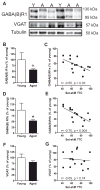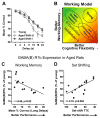Prefrontal cortical GABAergic signaling and impaired behavioral flexibility in aged F344 rats
- PMID: 26873002
- PMCID: PMC5333995
- DOI: 10.1016/j.neuroscience.2016.02.014
Prefrontal cortical GABAergic signaling and impaired behavioral flexibility in aged F344 rats
Abstract
The prefrontal cortex (PFC) is critical for the ability to flexibly adapt established patterns of behavior in response to a change in environmental contingencies. Impaired behavioral flexibility results in maladaptive strategies such as perseveration on response options that no longer produce a desired outcome. Pharmacological manipulations of prefrontal cortical GABAergic signaling modulate behavioral flexibility in animal models, and prefrontal cortical interneuron dysfunction is implicated in impaired behavioral flexibility that accompanies neuropsychiatric disease. As deficits in behavioral flexibility also emerge during the normal aging process, the goal of this study was to determine the role of GABAergic signaling, specifically via prefrontal cortical GABA(B) receptors, in such age-related deficits. Young and aged rats were trained in a set shifting task performed in operant chambers. First, rats learned to discriminate between two response levers to obtain a food reward on the basis of a cue light illuminated above the correct lever. Upon acquisition of this initial discrimination, the contingencies were shifted such that rats had to ignore the cue light and respond on the levers according to their left/right positions. Both young and aged rats acquired the initial discrimination similarly; however, aged rats were impaired relative to young following the set shift. Among aged rats, GABA(B) receptor expression in the medial prefrontal cortex (mPFC) was strongly correlated with set shifting, such that lower expression was associated with worse performance. Subsequent experiments showed that intra-mPFC administration of the GABA(B) receptor agonist baclofen enhanced set shifting performance in aged rats. These data directly link GABAergic signaling via GABA(B) receptors to impaired behavioral flexibility associated with normal aging.
Keywords: GABA(B) receptors; aging; baclofen; behavioral flexibility; prefrontal cortex; rat.
Copyright © 2016. Published by Elsevier Ltd.
Figures





Similar articles
-
Effects of acute administration of the GABA(B) receptor agonist baclofen on behavioral flexibility in rats.Psychopharmacology (Berl). 2016 Jul;233(14):2787-97. doi: 10.1007/s00213-016-4321-y. Epub 2016 Jun 2. Psychopharmacology (Berl). 2016. PMID: 27256354 Free PMC article.
-
Prefrontal cortical GABAergic dysfunction contributes to age-related working memory impairment.J Neurosci. 2014 Mar 5;34(10):3457-66. doi: 10.1523/JNEUROSCI.5192-13.2014. J Neurosci. 2014. PMID: 24599447 Free PMC article.
-
Age-related changes in tonic activation of presynaptic versus extrasynaptic γ-amniobutyric acid type B receptors in rat medial prefrontal cortex.Neurobiol Aging. 2016 Sep;45:88-97. doi: 10.1016/j.neurobiolaging.2016.05.015. Epub 2016 May 21. Neurobiol Aging. 2016. PMID: 27459929 Free PMC article.
-
Impact of anxiety on prefrontal cortex encoding of cognitive flexibility.Neuroscience. 2017 Mar 14;345:193-202. doi: 10.1016/j.neuroscience.2016.06.013. Epub 2016 Jun 15. Neuroscience. 2017. PMID: 27316551 Free PMC article. Review.
-
Alcohol, flexible behavior, and the prefrontal cortex: Functional changes underlying impaired cognitive flexibility.Neuropharmacology. 2024 Dec 1;260:110114. doi: 10.1016/j.neuropharm.2024.110114. Epub 2024 Aug 10. Neuropharmacology. 2024. PMID: 39134298 Review.
Cited by
-
Medial prefrontal-perirhinal cortical communication is necessary for flexible response selection.Neurobiol Learn Mem. 2017 Jan;137:36-47. doi: 10.1016/j.nlm.2016.10.012. Epub 2016 Nov 1. Neurobiol Learn Mem. 2017. PMID: 27815215 Free PMC article.
-
Stroke Induces a BDNF-Dependent Improvement in Cognitive Flexibility in Aged Mice.Neural Plast. 2019 May 5;2019:1460890. doi: 10.1155/2019/1460890. eCollection 2019. Neural Plast. 2019. PMID: 31191635 Free PMC article.
-
Discrimination performance in aging is vulnerable to interference and dissociable from spatial memory.Learn Mem. 2016 Jun 17;23(7):339-48. doi: 10.1101/lm.042069.116. Print 2016 Jul. Learn Mem. 2016. PMID: 27317194 Free PMC article.
-
The Aging Navigational System.Neuron. 2017 Aug 30;95(5):1019-1035. doi: 10.1016/j.neuron.2017.06.037. Neuron. 2017. PMID: 28858613 Free PMC article. Review.
-
Catecholaminergic Innervation of the Lateral Nucleus of the Cerebellum Modulates Cognitive Behaviors.J Neurosci. 2021 Apr 14;41(15):3512-3530. doi: 10.1523/JNEUROSCI.2406-20.2021. Epub 2021 Feb 3. J Neurosci. 2021. PMID: 33536201 Free PMC article.
References
-
- Arnsten AF, Cai JX, Murphy BL, Goldman-Rakic PS. Dopamine D1 receptor mechanisms in the cognitive performance of young adult and aged monkeys. Psychopharmacology. 1994;116:143–151. - PubMed
-
- Ashendorf L, McCaffrey RJ. Exploring age-related decline on the Wisconsin Card Sorting Test. Clin Neuropsychol. 2008;22:262–272. - PubMed
Publication types
MeSH terms
Substances
Grants and funding
LinkOut - more resources
Full Text Sources
Other Literature Sources
Medical
Research Materials
Miscellaneous

